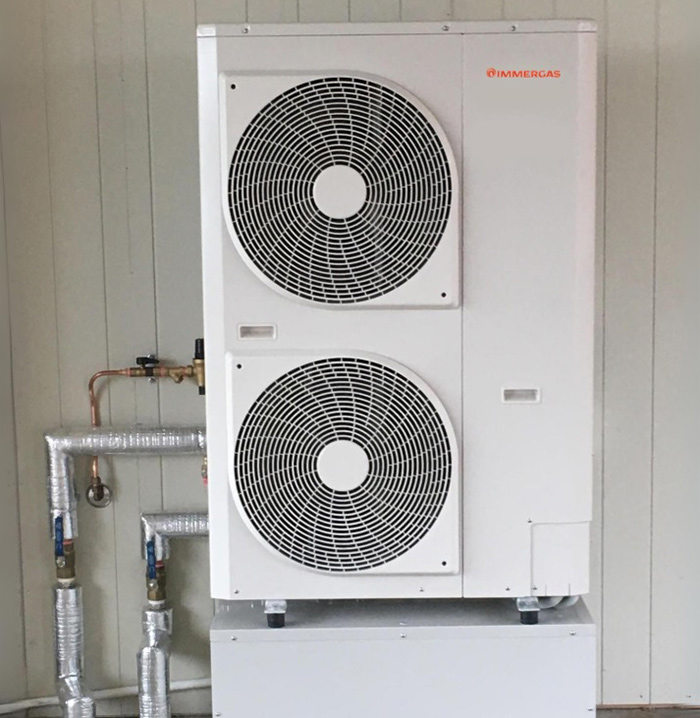Commercial building developers are under increasing pressure to reduce the carbon footprint of their projects, with the global focus on environmental sustainability continuing to intensify. ‘Carbon neutral’ has become somewhat of a buzz phrase in construction. It suggests a commitment or at least, effort towards, balancing the carbon emissions created by development with either carbon removal or offsetting practices.
For developers and consulting engineers, it’s essential that key contributors to carbon emissions and available sustainable solutions are known and understood.
Let’s explore what ‘carbon neutral’ means in development and how hydronic heat pumps can play an important role in helping to achieve this goal, which can, in turn, benefit you, your clients and the environment.

Carbon neutrality in commercial developments
From office buildings to retail complexes, commercial sites contribute significantly to carbon emissions globally, daily. In Australia, the commercial sector uses approximately 25% of overall electricity and is responsible for a total of 10% of the carbon emissions nationally.
Building developers, landlords and tenants are fast recognising that energy efficient heating and cooling can:
- Lower energy bills
- Attract more substantial rental returns
- Reduce running costs of business
- Slash carbon emissions
- Boost overall property value
So where to begin on reducing your existing site or development project’s emissions?
Here are the top contributors to carbon emissions from commercial buildings to consider:
Heating and cooling systems
Traditional climate control systems rely on fossil fuels to run and often account for the top share of a building’s emissions tally.
Electricity consumption
To power lighting, heating and cooling systems, appliances and any other equipment, electricity is required and this level of ongoing use across a commercial space can lead to substantial carbon emissions. This is particularly true of buildings that rely exclusively on non-renewable energy sources.
Construction materials
For the most part, the process of extracting and manufacturing construction materials is carbon intensive, further adding to the carbon footprint of the development.
Transportation
Emissions associated with the transportation required to collect and deliver materials to construction sites are another major contributor of carbon impact – this can range from local, state or nationwide road and ocean freight to international transportation via air, sea, road or a combination of modes.
Hydronic heat pumps – the sustainable solution
A professionally installed and well-maintained quality heat pump is known to maintain a space at a whopping 400% efficiency, compared to gas heating systems, which hover in an efficiency range of 70-98%.
Integrating a heat pump into your next project has the strong potential to revolutionise the temperature control of the entire space and offer a strong marketing angle to any potential investors or buyers.
The benefits of hydronic heat pumps
While there is an abundance of benefits of commercial heat pumps, we’ve rounded up the top five to get you started.
Energy efficiency: Heat pumps extract heat from renewable sources including the ground or air and in doing so require less energy to generate heating or cooling. This results in a massive reduction in carbon emissions and makes them highly energy efficient.
Reduced fossil fuel dependency: Where traditional heating systems rely on fossil fuels to run, hydronic heat pumps are powered by electricity, which can be sourced via renewable energy providers and further reduce emissions. Pairing a hydronic heat pump with solar panels is a sure-fire way to reduce bills and carbon footprint.
Precise temperature control: Pairing a hydronic heat pump with hydronic heating and cooling solutions throughout your commercial project space will enable precise temperature control using thermostats. Pre-set temperatures will ensure optimal comfort year-round, while concurrently avoiding energy waste.
Product lifespan: If hydronic heat pumps are well maintained, they will have a much longer operational life compared to traditional HVAC systems. This decreases the need for ongoing replacement parts and servicing and the associated carbon footprint. A well-maintained heat pump can last double that of a boiler – 20 years plus is not unheard of.
Zoning: Using thermostats, hydronic heat pumps linked to systems that include underfloor heating, radiators, or in-floor trench heating, can be zoned. This means that any area of your commercial build can have a specific temperature nominated for now, or on timer for later. This approach optimises energy use.
Steps to carbon neutrality
By integrating heat pump hydronic heating into commercial project builds, engineers and developers alike can make substantial impacts in reducing the carbon footprint.
Step one: Assessment
Begin by conducting a thorough assessment of the building’s energy use and emissions. This will enable the most carbon-intensive areas to be identified so solutions can be considered and proposed that align with sustainability goals.
Step two: System design
Engineers can collaborate with architects and hydronic heating and cooling consultants to design a system that maximises the potential of hydronic heat pumps for the site. This includes optimising system size, layout, and integration with other energy-efficient technologies.
Step three: Integrate renewable energy
Combining hydronic heat pumps with renewable energy sources and technology, such as solar panels and solar batteries, can further reduce a site’s reliance on fossil fuels and accelerate its ability to reduce carbon emissions and get closer to carbon neutral.
Step four: Analysis
Running follow-up assessments to evaluate the long-term environmental impact of heat pumps will create valuable insights for future projects and track the ongoing energy efficiency of the existing site.
Insert Image Hydronic-Heating-system
Hunt Heating – hydronic heat pump specialists
The integration of hydronic heat pumps is a sustainable and efficient solution for any commercial build. By addressing the significant contribution of heating and cooling systems to carbon emissions, engineers and developers can lead the way to a more environment-friendly future for commercial developments.
At Hunt Commercial, we are here to support developers and engineers to make sustainable choices in residential and commercial climate control.
Contact us today to discuss your heating and cooling requirements for your next project.

